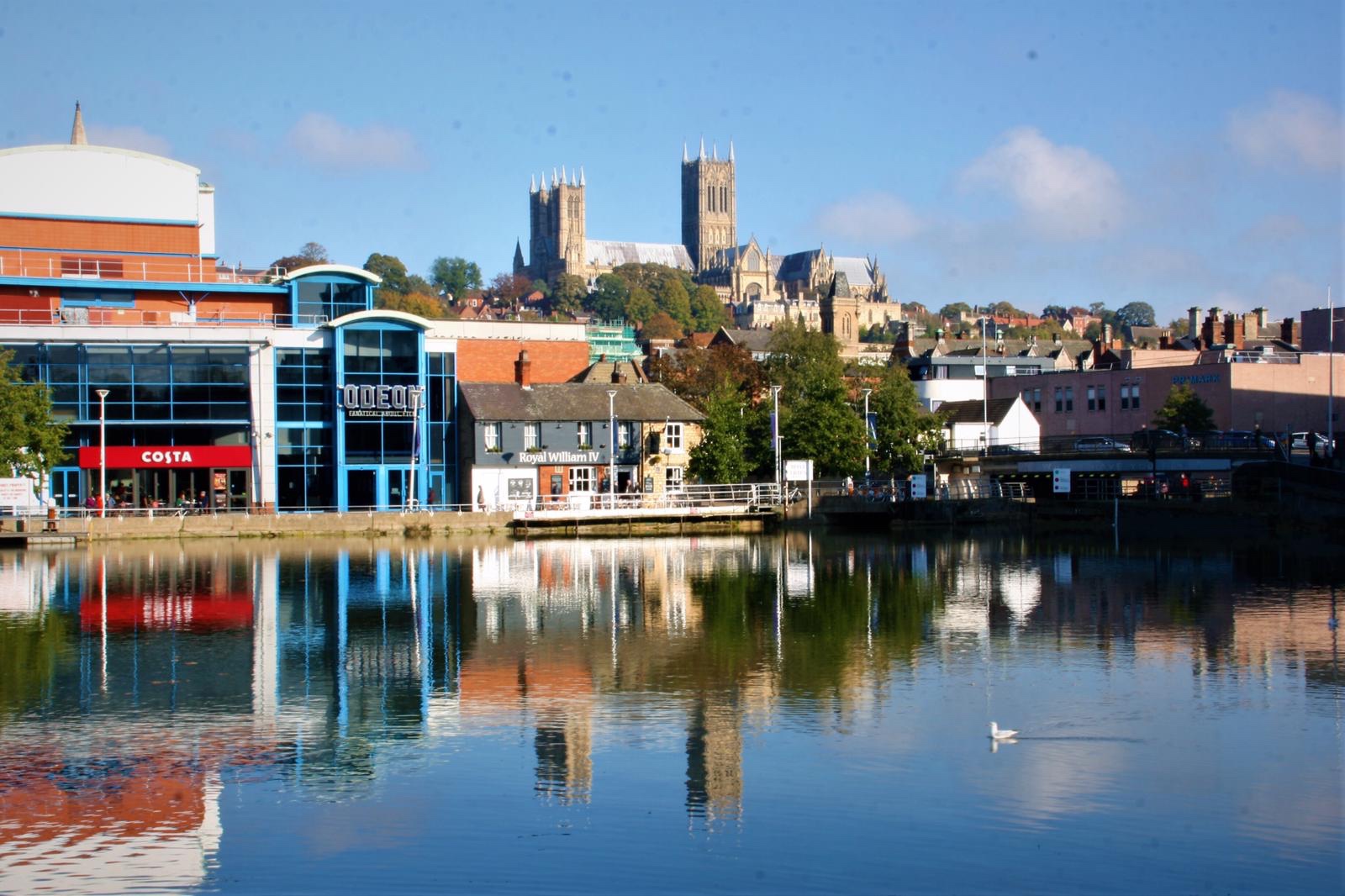Lovely Lincoln – another city spanning the 2000yr history of Britain. Sounds familiar? Similar to the recent visit Characterful Chester. My job recently has taken me to all points of the compass of this land. I have questioned the logistics of this, and these trips haven’t always made me very happy, but on occasions it presents the opportunity to explore parts of the country not always accessible to me. Lovely Lincoln was my opportunity today; the sun was shining, and my appointment had cancelled. Not one to waste time but seize every chance offered to explore these green and pleasant lands I set off for the city of Lincoln. I perhaps should have completed some admin, but that can be completed in the evening when the sun isn’t shining. I’d heard rumours of its reputed beauty and that it was home to an impressive cathedral, but my knowledge of Lincoln was only its recent cup giant killing success as seen in the football on TV. I didn’t even have any childhood memories of being brought here. I’m sure that my father would correct me if this was the case. He has.

I parked the car legally in a car park adjacent to the castle. I had a quick scan of the local tourist boards to establish a route by which to walk. The car park I chose was ideally located close to the cathedral quarter which meant I avoided the modern metropolitan monstrosity that most people think makes a city. I, on the other hand, much prefer ancient architecture, an abundance of evidence of our history and charming shops and eateries. Lincoln somehow manages to play host to what I love and what I don’t love in cities. I set off at pace, with slightly cold fresh air filling my lungs and the autumnal sunshine beating down on my neck. The smile on my face gave it away. Fine weather on these ventures make me incredibly happy. Sunshine always helps when exploring and I find it adds to and enhances the intrinsic layers of beauty that some places exhibit.
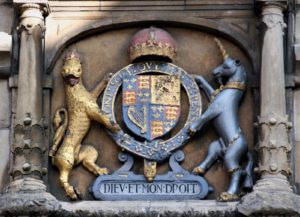
Lincoln is a small cathedral city in eastern middle England. These small cathedral cities are rapidly becoming my favourite cities in England, if not the world. These cities were once the power houses of this country yet now they seem to play second fiddle to more modern places. There was good and bad that accompanied the Industrial Revolution. The Romans clearly had a good eye for a location as they laid down the first roots of this city. The Roman fort that was established on top of the hill has evolved throughout time, yet still remains after all the different eras of our history.
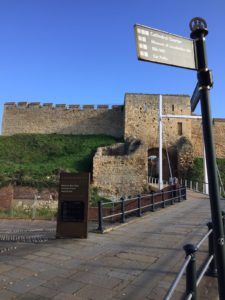
The perfect place to start was to examine the castle. Not until further exploring the city did it identify its perfect strategic location. It is not too far from the coast; was it perhaps the first line of defence for anticipated invasions of Britain? (I am reminded that no one has successfully invaded these shores since 1066) but back then the Romans may have thought so as they established a fort here. Once their era had finished and the Middle Ages commenced, it was time for the great influence of William the Conqueror, who invaded the city two years after his initial landings on these shores. He ordered that the castle and later the cathedral to be built on the former Roman fortifications. How lucky we were for his decisions, for the footprint he has left, which has survived the test of time. It is truly stunning. Perhaps things as they are now (decorative) are not according to the initial vision. The location for both on top of hill would have surely meant perfect defensive positions.

The castle to this day is immaculately presented from the outside. Its fortified walls every bit the castle image I had grown up to know. Strolling around the parameter of these walls there was no evident signs of a keep. A couple of round towers exist in the corners as expected to defend the wall. So with trepidation I stepped towards the main gate to enquire how much I may have to fork out to visit Lincoln castle. Both a pleasant surprise and unhealthy shock greeted me. Access into the castle and grounds was free… can you believe it, what a pleasant surprise? Then the shock… £8 to be allowed to walk around the walls. I almost dropped my camera. After visiting recent cities where city walls have been free to access, I couldn’t believe the fee that was being asked. No doubt they provide stunning views and need maintenance, but surely they cannot justify the price tag. Sorry Lincoln Castle, but no! A rather disheartening walk around allowed me to see the courthouse and Victorian building now located in its centre, but I ultimately left greatly disappointed.
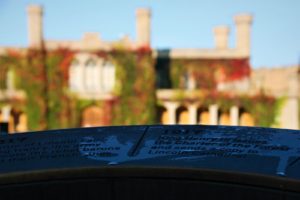
Upon leaving the castle, with sun still shining I went in search of other charms rather than drag myself into the cathedral and lose that glorious autumn sunshine. I meandered my way along the cobbled paths that enhance the olde worlde feel of this part of Lincoln. Shoppers should delight in the unique boutiques and quirky shops that line the roads. Their bright, colourful facades even managed to tempt me in. Meandering around, my footsteps led me down Steep Hill – the connecting link between ‘downhill’ and ‘uphill’. A steep yet charming street of shops illustrating the point made above. Thoughts immediately turn to other similar locations that have been visited for comparison, with ones that spring to mind being in Quebec and Hovis Hill. Quebec, by contrast, is more steps than a steep pebbled incline, but similar in the range of shops and array of colours that adorn these streets. Hovis Hill can replicate the steepness and pebbled road aspect but is a residential area. In leaving the old behind I waltzed under the archways of the guildhall into the chaos of the new. Oh, take me to the old, narrow, quiet and charming quarter I had left behind.
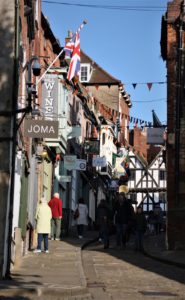
But in search of visiting all of Lincoln’s history I had to grim and bear the hustle and bustle to get myself to Brayford waterfront. My route took me past the war memorial and an unloved church. Close by should be High Bridge, which is oldest bridge in Britain which still has buildings on it. Thankfully I managed to stumble upon that on my return back to more poetic surroundings. Some solace was found down by the Britain’s oldest inland port. Out of season waterways meant calming and undisturbed waters. These provided wonderful reflections of the city and highlighted the dominance that the cathedral plays in the cityscape, the castle hidden mostly by modern buildings. Now a hub of student life and modern entertainment there are still clear signs that this was once a thriving port. Many pleasure boats replace the steamboats and barges that would once have filled this port. During the 13th century, when Lincoln’s wool trade was thriving, so was the port. Decline set in but with every decline comes a resurgence. The connecting waterway was dredged and reopened which led to its heyday in the 18th/19th century. The port we see today would have been a much different picture back then. From here the decline came again as the railway arrived and the port was left to wrack and ruin. It now survived and has been turned around to a thriving pleasure destination.
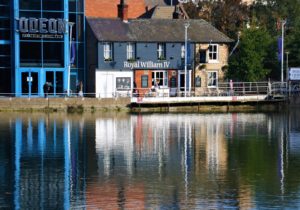
So I left the waterways after finding the high bridge and retraced my steps up Steep Hill, past those appealing shops, round the corner and through the arches to the cathedral. Sadly, that grand entrance was greeted with the noise and clear disturbance of necessary renovation works. How annoying, but understandable, it must surely present a reason to return. A step inside one of England’s biggest cathedrals is a must, but a shocking fee of £8 to enter may put you off. I have to say I was put off by the fee and will add this as another reason to come back and visit. A wander round the outside confirms the enormous size of it and its unique design. Not like the other cross liked cathedrals in England, this Norman and Gothic combination is superb. Did you know that Lincoln cathedral was the tallest building in the world for 238 years? In 1311 the completion of the central tower replacement was done at 160m high. In 1548 this was blown down. Incredible bits of history on both aspects in the building of something so high and the fact it probably wasn’t very safe to be a builder back then.

So as I sit and enjoy the autumn sunshine, and compose the blog for this city I reckon that this is another jewel in the English crown that should be added to anyone’s itinerary and not ignored when visiting this country. I for sure will be returning to explore its history and surrounding area.

